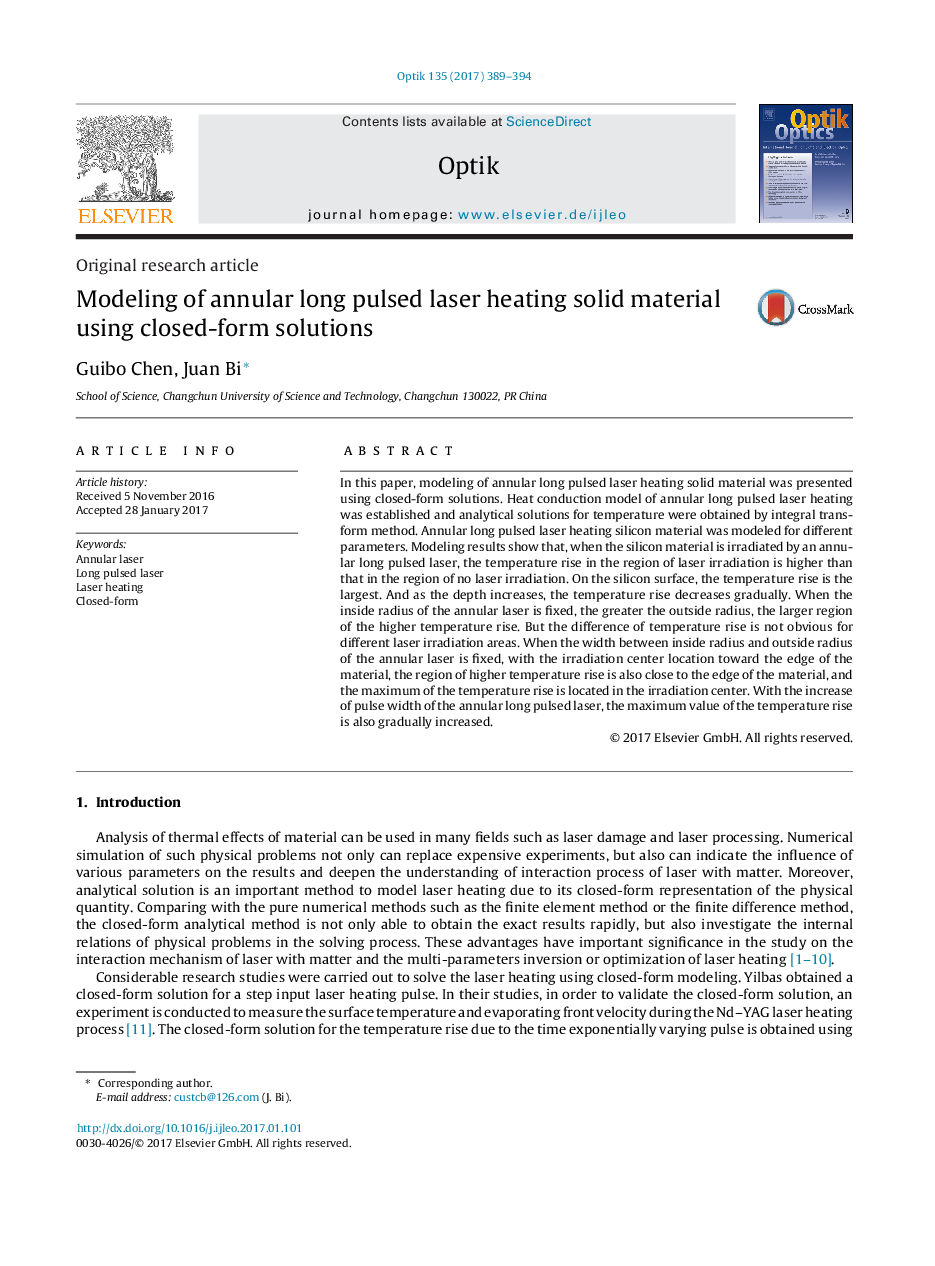| کد مقاله | کد نشریه | سال انتشار | مقاله انگلیسی | نسخه تمام متن |
|---|---|---|---|---|
| 5025836 | 1470592 | 2017 | 6 صفحه PDF | دانلود رایگان |
عنوان انگلیسی مقاله ISI
Modeling of annular long pulsed laser heating solid material using closed-form solutions
ترجمه فارسی عنوان
مدل سازی مواد جامد لیزر پالسی حلقوی با استفاده از راه حل های بسته
دانلود مقاله + سفارش ترجمه
دانلود مقاله ISI انگلیسی
رایگان برای ایرانیان
کلمات کلیدی
لیزر زاویه ای لیزر طولانی پالس، حرارت لیزری، شکل بسته
ترجمه چکیده
در این مقاله، مدل سازی مواد جامد جامد لیزر پالسی حلقوی با استفاده از راه حل های فرم بسته ارائه شده است. مدل هدایت حرارتی گرمای لیزر پالس حلقوی حلقوی ایجاد شد و راه حل های تحلیلی برای دما توسط روش تبدیل انتگرال بدست آمد. ماده سیلیکونی لیزر پالسی مولکولی برای پارامترهای مختلف مدلسازی شده است. نتایج مدل سازی نشان می دهد که هنگامی که ماده سیلیکون توسط یک لیزر پالسی بلند حلقوی تابش می شود، افزایش دما در ناحیه تابش لیزر بالاتر از منطقه بدون تابش لیزر است. در سطح سیلیکون، افزایش دما بزرگترین است. و با افزایش عمق، افزایش درجه حرارت به تدریج کاهش می یابد. هنگامی که شعاع داخلی لیزر حلقوی ثابت می شود، بیشتر شعاع بیرونی، منطقه بزرگتر از افزایش درجه حرارت بالاتر است. اما تفاوت در افزایش درجه حرارت برای مناطق مختلف تابش اشعه آشکار نیست. هنگامی که عرض بین شعاع درونی و شعاع بیرونی لیزر حلقوی ثابت می شود، با محل مرکز اشعه در کنار لبه ماده، منطقه افزایش دمای بالاتر نیز نزدیک به لبه ماده است و حداکثر دما صعود در مرکز تابش قرار دارد. با افزایش پالس لیزر پالس طولانی حلقوی، حداکثر مقدار افزایش دما نیز به تدریج افزایش می یابد.
موضوعات مرتبط
مهندسی و علوم پایه
سایر رشته های مهندسی
مهندسی (عمومی)
چکیده انگلیسی
In this paper, modeling of annular long pulsed laser heating solid material was presented using closed-form solutions. Heat conduction model of annular long pulsed laser heating was established and analytical solutions for temperature were obtained by integral transform method. Annular long pulsed laser heating silicon material was modeled for different parameters. Modeling results show that, when the silicon material is irradiated by an annular long pulsed laser, the temperature rise in the region of laser irradiation is higher than that in the region of no laser irradiation. On the silicon surface, the temperature rise is the largest. And as the depth increases, the temperature rise decreases gradually. When the inside radius of the annular laser is fixed, the greater the outside radius, the larger region of the higher temperature rise. But the difference of temperature rise is not obvious for different laser irradiation areas. When the width between inside radius and outside radius of the annular laser is fixed, with the irradiation center location toward the edge of the material, the region of higher temperature rise is also close to the edge of the material, and the maximum of the temperature rise is located in the irradiation center. With the increase of pulse width of the annular long pulsed laser, the maximum value of the temperature rise is also gradually increased.
ناشر
Database: Elsevier - ScienceDirect (ساینس دایرکت)
Journal: Optik - International Journal for Light and Electron Optics - Volume 135, April 2017, Pages 389-394
Journal: Optik - International Journal for Light and Electron Optics - Volume 135, April 2017, Pages 389-394
نویسندگان
Guibo Chen, Juan Bi,
